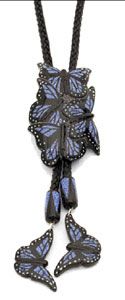By Dottie Indyke
A Lakota artist specializing in buffalo-horn jewelry brings new attention to the medium
Ever since the gold-rich Black Hills were taken from the Oglala Lakota Indians, the tribe has avoided using gold in their jewelry. So for his earrings and necklaces, Kevin Pourier substitutes a different precious material: It’s an anomaly in the jewelry world, but one that is sacred to his people.

Pourier uses horn caps from buffalos, which the Lakota people believe are their sacred relatives. His jewelry, spoons, and cups are composed of stunning bas-relief designs made with mother-of-pearl, pipestone, lapis, sandstone, malachite, and coral as well as the buffalo horn and set against intricately carved background patterns and textures. He is known for his meticulous inlay work, in which finely crushed stones and shells are mixed with resins and set in minuscule channels.
His passion for his people is expressed in designs inspired by symbols from nature, such as the butterfly, that have tribal significance, and by images depicting the injustices of history: One of his elaborate spoons portrays a buffalo cleaving Mt. Rushmore in two.
Buffalo-horn cups and spoons have been made by the Lakota for centuries, but Pourier contributes a contemporary aesthetic that elevates the genre to fine art. Although he has been recently recognized—with a fellowship from the Southwestern Association for Indian Arts (SWAIA) in 2004, a Smithsonian fellowship in 2005, and a Bush Foundation fellowship in 2006—his innovative work is often misunderstood, commonly mistaken for ceramics. Until he convinced them that the form has been practiced by his tribe for generations, even SWAIA, which sponsors Santa Fe’s Indian Market, banned what they called his “chip inlay” technique. “I was so distraught over this,” Pourier recalls, “I couldn’t work for six months. They told me to do mosaic or silver work. But I wouldn’t give up the horn.”
Art making, for the 47-year-old, is a relatively recent discovery. As a kid of mixed heritage growing up in Rapid City, SD, he regularly experienced prejudice. On the Pine Ridge reservation where he was born, he was considered white; in the city, he was a red man. Directionless, he began drinking at 12 and spent his 20s in a fog of alcohol and drugs.
He was working 12-hour shifts at a particleboard factory in Rapid City when one of his biker friends gave him a piece of deer antler. Pourier taught himself to carve, learning more, he claims, from trial and error than from any formal instruction he might have received.
In 1990 he hit bottom and, with the help of Alcoholics Anonymous, began the clean-and-sober chapter of his life. He met his future wife, Valerie, chucked his mind-numbing job, and moved back to the reservation, to the parcel of land where his great-grandfather lived 100 years ago.
Encouraged by an acquaintance, Pourier entered one of his deer-antler carvings in the Black Hills Art Expo and came away with a second-place ribbon and $2,000 in sales, a sum that would have taken him two months to make at the factory.
Over the past decade, Pourier’s impressive accomplishments have been achieved through determination, talent, and a drive to inspire local kids who are growing up in the poorest county in the country, where health care is substandard, housing is at a premium, and drugs and alcohol are epidemic. Pourier dreams of taking a handful of young people to the Smithsonian Institution in Washington, DC, to see the awe-inspiring objects, such as Crazy Horse’s horn cup, once crafted by the Oglala Lakotas.
“It’s sad,” he says. “None of those pieces are here—all of them have been taken away. I’d like to take kids out of this oppressive atmosphere and show them that we can make a better life for ourselves.”
As hokey as it may sound, Pourier says, he believes he’s the beneficiary of divine intervention. How else to explain the $48,000 unrestricted Bush Foundation grant he recently received, which he will use for research trips and to fund the construction of a warm, well-lit, leak-free studio? Or the recent inclusion of three of his spoons in the prestigious Changing Hands: Art Without Reservation 2 traveling exhibition, organized by the Museum of Arts and Design? Attending the opening of the show in New York City earlier this year, Pourier was struck by the improbability that buffalo horn would deliver him into the heart of the mainstream art world.
“I’ve never quit,” he says in looking back at the factors that have supported his success. “When the Indian Market rules changed, I decided to stand up for what I believed in, even when I was labeled a radical. I’m just sticking up for my family and our livelihood. It’s what I think a modern-day warrior would do.”
Pourier’s work can be seen at Indian Market in Santa Fe, NM; the Heard Museum Guild Indian Fair & Market in Phoenix, AZ; and www.kevinpourier.com.
Featured in “Native Arts” September 2006





